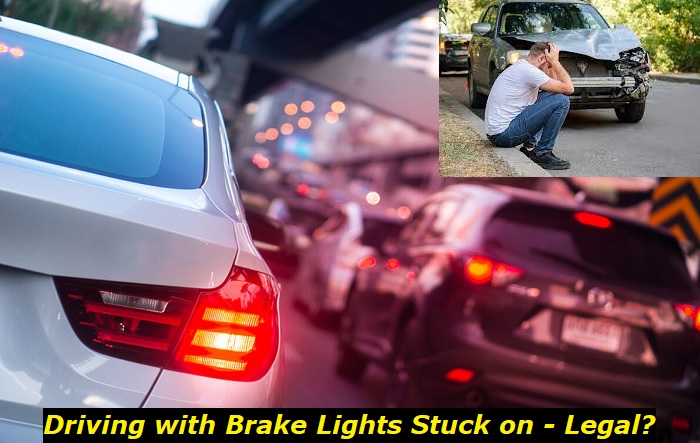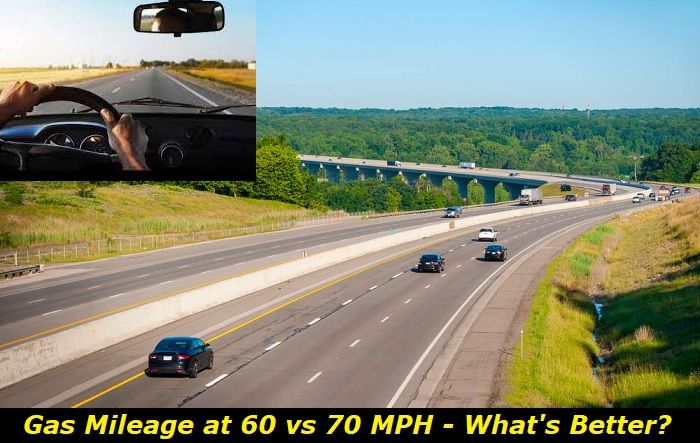It's common knowledge that driving with a broken brake light is illegal. Your brake light alerts drivers behind you that you're slowing down and helps prevent accidents. A bad brake light can cause accidents. Another question is whether it is illegal to drive with your brake lights stuck on.
Car lights problems highlights
- Level of urgency:low
- DIY inspection:possible
- DIY repairs:possible
- Can you drive?yes
- Price of repairs:$20 - $150
- If ignored:fines, discomfort, poor visibility
- Ways to fix:check fuses, check lamps, check wiring

Why is it Illegal to Drive with Your Brake Lights On?
It is illegal to drive with your brake lights on because it constitutes a driving hazard for drivers behind you. Brake lights keep you safe by letting other drivers know when you're slowing down or coming to a stop, allowing them to react on time.
When your brake lights are stuck on, drivers behind you won't know when you're slowing down or not. It can disrupt the flow of traffic and lead to unsafe driving conditions.
It's annoying not to be able to drive your car legally, especially over something like a stuck light. If you're planning to get your car back on the road again, you'll need to understand the causes of this issue.
Why Are My Brake Lights Stuck On?
There are many reasons why your brake lights might be stuck on. This problem usually points to a mechanical problem with the brakes or an electrical problem with the lights. Knowing what's causing your lights to stay on is the first step to fixing the issue and making your car legal to drive again.
1) Malfunctioning Brake Light Sensor or Switch
This is the most common cause of a stuck brake light. The brake light switches and sensors detect whether the pedal is up or down, and send the appropriate signal to either turn the brake light on or off. It's quite easy to see how a faulty brake light switch or sensor could cause the brake light to stay on, even when the brakes aren't being pressed.
2) Stuck Brake Pedal
Every driver is familiar with how a functioning brake pedal should operate. The brake pedal goes down when you press on it, causing the brake lights to come on and the car to slow down. Once you release the pedal it should come back up and the car will pick up speed.
An old or faulty brake pedal might not feel as responsive as it should. The pedal might come back up slowly, or it might not come back up all the way. This results in the brakes staying engaged, which causes the brake lights to stay on.
The brake pedal can get stuck as a result of a damaged mechanism, corrosion, lack of lubrication, or a buildup of dirt.
3) Malfunctioning Electrical System
The brake lights in your car are controlled by the electrical system. A short circuit or electrical fault in this system can prevent the lights from operating normally. In some cases, this can result in the lights not being able to come on. In other cases, the lights might stay on permanently.
A malfunctioning electrical system could be a result of worn wires, a loose electrical harness, or a malfunction in the Body Control Module (BCM).
4) Bad Brake Pedal Bumper
The brake pedal bumper is a plastic pad that presses the brake switch when the brake is not depressed. The bumper can wear down and break apart with age or exposure to heat. When this happens, the brake pedal bumper won't be able to close the brake switch, and the brake light will remain on.
You can check if your bumper has deteriorated by examining the floor near the brake pedal. If you see signs of white, blue, or black rubber crumbs, then the bumper has fallen apart and needs to be replaced.
5) The Parking Brake is Engaged
This might seem to be an unlikely reason for your brake lights to stay on, but it is more common than you might think. In most cars, the brake lights will come on when the parking brake is engaged. This happens even if the parking brake is only partially engaged.
A sign that your parking brake might be partially engaged is when you notice sluggish acceleration, a squealing sound or a burning smell as the car drives, and dragging tires.
How Can I Fix My Brake Lights?
To legally drive your car again, you will need to repair the brake lights. As we have seen, there are quite a few different reasons your brake lights might stay on. Here are the methods you can use to fix the cause of your brake light problem.
1) Replace the Brake Light Switch
If the brake light switch is defective, it will need to be replaced. This can be done by a trusted mechanic, but you can also replace the switch yourself if you have experience repairing electronics.
Here are the steps you need to follow to replace the brake light switch.
- Disconnect the negative terminal of the battery.
- Unplug the electrical connector of the brake light switch.
- Remove the bolts holding the brake light switch in place. Depending on your car you might have up to four.
- Unscrew the brake light switch from its mounting.
- Disconnect the switch from its wiring harness.
- Remove the switch.
- Once you have removed the faulty switch, you can begin to install the new one.
- Once you have installed the switch and connected the battery, you should test the new switch by pressing and releasing the brake pedal and checking whether the lights are responsive.
2) Repair the Electrical System
If you're dealing with a faulty electrical system, you will most likely need to contact an automotive electrician. If you have some electrical repair experience, there are some signs of electrical problems that you can search for yourself.
First, examine the brake light wiring and look for born or frayed wires. You can also check for loose or corroded connectors. If you find any signs of damage in these parts, you can replace the damaged part.
You can also take your car to the dealership to have the body control module inspected for damage and replaced if needed.
3) Clean and Lubricate the Brake Assembly
if the brake pedal feels stiff or unresponsive, then it might be stuck. To fix this, you'll need to find out why the brake pedal is stuck and then find a way to unstick it.
First, you should check the brake pedal assembly. Look for signs of corrosion, grime, or anything else that might be jamming the assembly. If you find signs of grime, use a cloth and some cleaning fluid to wipe down the assembly until the grime is gone.
After cleaning the assembly, make sure it's lubricated. You can do this by spraying WD4 onto the joints. You can also spray the metal parts of the assembly will WD40 to protect them from corrosion.
Make sure to remove any small objects that might prevent the pedal from depressing fully, or that could jam the assembly. Make sure to always keep the foot space of the driver's side clear of clutter.
4) Replace the Brake Pedal Bumper
if the brake pedal bumper has deteriorated, you will need to replace it. Replacing the brake pedal bumper is as simple as removing the old one and inserting the new one in its place.
Make sure to get a replacement bumper that is the same size as the old one. If the new bumper is bigger or smaller than the old one, you may find that your brake lights aren't as responsive as they should be.
5) Release the Parking Brake
You can check whether the parking brake is engaged or not. If the parking brake is engaged, even partially, it could cause the brake lights to come on. Simply disengage the parking brake and the brake lights should turn off.
Conclusion
It is illegal to drive with brake lights that are not properly functioning. This means that whether your brake lights don't turn on, or they are stuck on, it is illegal to drive with them in that condition. This is because faulty brake lights pose a driving hazard to you and any drivers behind you. Brake lights that are stuck on will not let the drivers behind you know when you're slowing down. They can also cause drivers behind you to drive slower than necessary, disrupting the flow of traffic.
When your brake lights are stuck on, it is usually a result of a faulty electrical system, brake light sensor, or a mechanical problem with the brake pedal assembly. There is also the possibility that the parking brake is engaged either partially or totally.
About the authors
The CarAraC research team is composed of seasoned auto mechanics and automotive industry professionals, including individuals with advanced degrees and certifications in their field. Our team members boast prestigious credentials, reflecting their extensive knowledge and skills. These qualifications include: IMI: Institute of the Motor Industry, ASE-Certified Master Automobile Technicians; Coventry University, Graduate of MA in Automotive Journalism; Politecnico di Torino, Italy, MS Automotive Engineering; Ss. Cyril and Methodius University in Skopje, Mechanical University in Skopje; TOC Automotive College; DHA Suffa University, Department of Mechanical Engineering






Add comment